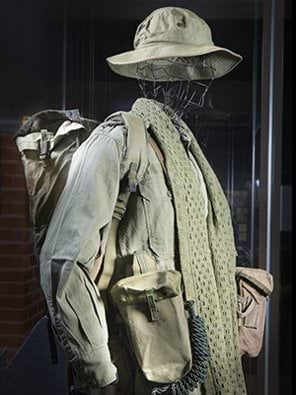
- Conflict:
- Vietnam War (1962-73)
- Service:
- Army
Military uniforms perform multiple functions. In battle they offer protection, camouflage, comfort, and, importantly, distinguish between opposing combatants. Behind the frontline they promote cohesion within the military unit, easily identifying a group, while rank insignia establish a disciplinary hierarchy. In a museum they take on a new educative role.
The Shrine has received a recent donation of a set of Australian Army ‘Jungle greens’. The uniform and ancillary equipment were used by 2nd Lieutenant Robin Hunt, 107th Field Battery, Royal Regiment of the Australian Artillery, during his Vietnam War service (1970–71). The collection offers the Shrine a variety of interpretive opportunities.
This unusually complete example of the uniform, worn by artillery and other soldiers during the Vietnam War (1962–75), enables visitors to gain an appreciation of the rigours of a soldier’s life. The uniform itself is relatively light-weight cotton, but the gear carried, either in the pack or attached to the webbing, such as rations, water bottles and full ammunition pouches, could weigh anything from 30 to 40 kilograms. Notable is the ‘sweat rag’ or scrim, used for a variety of purposes, including absorbing sweat, camouflage or as a bandana.
In the Galleries of remembrance this uniform illustrates Lieutenant Hunt’s personal story while also expanding the timeline of uniform development on display. Colourful 19th century examples give way to the heavy woollen khaki of the First World War (1914–19) and the early notions of terrain appropriate gear evidenced by the desert and jungle colours of the Second World War (1939–45). This Vietnam era uniform demonstrates an increased desire for flexibility and functionality combined with enhanced camouflage potential. However, when compared to the shielding provided by the advanced materials and body armour used in current conflicts, its protective value seems virtually nil.
One of the hallmarks of Australian uniforms, from the First World War onwards, has been their capacious pockets, visible here on the trouser legs. This donation includes a wealth of material that Lieutenant Hunt carried in his pockets on operations, not least his personal notebooks, with important reminders and charts required to carry out his duties.
These notebooks, together with various training and jungle warfare booklets, are good examples of artillery and army working documents and offer great insight into Australian procedures during the Vietnam War.
Despite a certain amount of ‘South Vietnam red dust’, as Hunt puts it, this collection is not only remarkably complete but remarkably well kept—right down to the bootlaces, often one of the first items to be repurposed post-service.
The starch from the shirt’s final clean in Vietnam is still evident in the crispness of the material and the boots still hold their polish.
Lieutenant Hunt’s foresight in packing and keeping his gear so scrupulously has resulted in a versatile addition to the Shrine’s collection, which may be used to educate visitors and commemorate the service of Vietnam veterans long after the war.
Author:
Katrina Nicolson has been a Research Officer with the Shrine of Remembrance since 2011. She has worked on many exhibitions including Indigenous Australians at War: from the Boer War to the Present, The ‘Blood Tub’: Australians at Bullecourt, Pozieres,1966: The Year that changed the World, Brigadier Walter and Helena Cass and is co-curator of the Shrine’s travelling exhibition, Australia Will Be There: Victorians in the First World War (1914–19).
Updated
